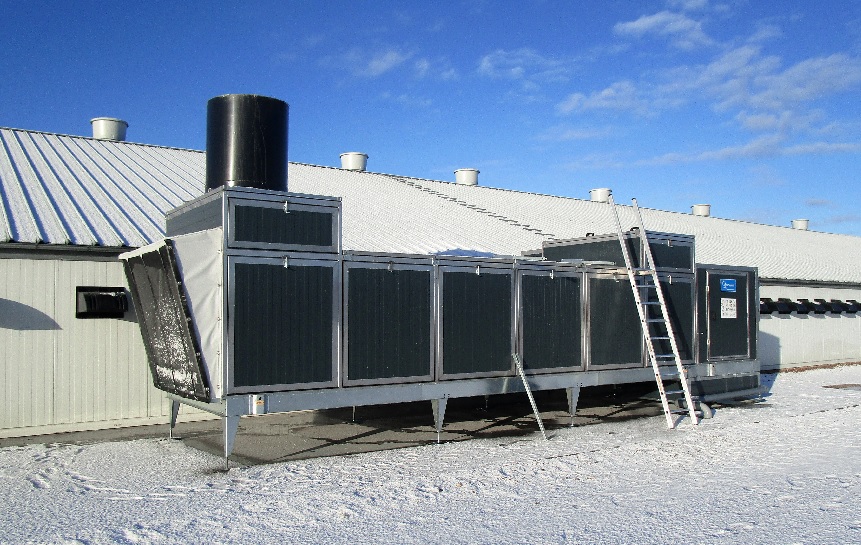In Canada, the weather extremes are considerable: it can be very cold for long periods of time, and you can also have very hot summers. A heat exchanger can be an important piece of equipment for a broiler farmer to optimise his production runs. Heat exchangers are designed to create a year-round optimal climate that manages the impact of external weather conditions and their effect on the
climate inside the house. How to choose the heat exchanger to suit your needs? Let us guide you through the most important factors so you can take these into account when considering investing in heat exchangers.
What is a heat exchanger?
First of all, let’s explain what a heat exchanger is; it is a system that transfers heat, also called thermal energy, from one fluid to another without mixing the two fluids. The fluids can be separated by a solid contact surface with high thermal conductivity. It is important that the fluids do not mix or get in direct contact with each other. In the case of an ECO Unit, this means that the warm exhaust air from inside passes the fresh cool air from outside by going through up to 1,325 m2 of contact surfaces inside the heart of the unit.
As a broiler farmer, why would you use a heat exchanger?
If you are able to recover heat from your stables, it will mean you do not need to bring in heat from external resources like fossil fuels, which nowadays cost a fortune! So the recovery of heat provides almost instant savings on your energy costs. This is just one advantage, even more importantly the installation of a heat exchanger can help you create an improved climate for your birds. And the better the climate the better your broilers will perform, reducing FCR rate, and improving your yields
What types of ECO Unit heat exchangers do we have available?
Not every broiler farmer will require the same climate conditions, and each will have unique considerations that will affect their setup. Regardless, it is still essential to have a climate and get the right temperature in the broiler house for the best growing conditions for your birds. There are different types of heat exchangers that can circulate different levels of air an hour, up to 30,000 m3 per hour. These always have higher performance ratios vs smaller heat exchangers. Our air-to-air heat exchanger is specifically designed for use in poultry houses and designed for large air volumes. It is also robust - meaning that it can handle relatively dirty outgoing air containing dust and ammonia - and easy to clean.
How are you going to distribute the air in the house?
There are different ways to distribute the air. The preheated air can be brought into the house via a Louvre system as we use in the ECO Unit 200 or via aeration tubes like in the ECO Unit 800. Both methods bring the preheated air to the centre of the barn and with the help of downward fans, we bring the heat to bird level. After all, it is no use in the heat staying on the ridge of the house, when the birds are located at ground level. Other ventilation systems often bring the cold air straight to ground level, which can negatively affect the birds’ well-being.
How much heat do you recover with a heat exchanger?
At Vencomatic Group, we have an average of 80% thermal recovery. What does this mean? Well if it is 32 Fahrenheit ( 0° Celsius) outside and 68 Fahrenheit (20° Celsius) inside, you can recover 80% of the temperature difference and heat up the incoming air by around 16 degrees. This is achieved by the warm air going through this long route of up to 1,325m2, which is a lot of contact surfaces where
we can capture the heat before it gets released into the outside environment.
How much energy do you use with a heat exchanger?
Electrical energy is mainly used to move the airstreams of warm exhaust air and cool fresh air through the heat exchanger. In addition to this, you need to select a heat exchanger like the ECO Unit that keeps back pressure - i.e. aerodynamics – as low as possible, which also helps to keep costs down.
What do you have to think about in terms of maintenance for a heat exchanger?
Cleaning is particularly important; all heat exchangers get dirty. This means you will regularly need to stop the machine and clean it thoroughly removing all dirt and dust collected over time for the unit
to function appropriately. ECO Units are available with an automatic cleaning option, which reduces the workload significantly and allows you to focus on your bird management rather than cleaning jobs. How does that work? Well, the dust that remains in the ECO Unit is discharged by means of a built-in washing installation, the condensation that forms in the ECO Unit is stored and reused for washing, which also means you keep water consumption at a minimum level.
In addition, especially in Canada where you have long winters with deep frost, it is almost impossible to clean a heat exchanger that is placed outside. In Canada, an automatic cleaning system is therefore standard for us.
What control do you put on a heat exchanger?
There are several factors that determine the optimal control of the heat exchanger. The controls of Vencomatic Group's ECO units can be integrated, but they can also work as a standalone. If there is a
Navi Controller, we can also link to it most of the time.
What does a heat exchanger cost?
Apart from the purchase cost, you must also take into account 20-30% extra costs for installation, such as cabling and possibly a concrete slab to place the unit on. The costs can be recovered in
various ways:
● Fossil fuel bill savings, especially in cold areas like Canada. Gas bills can be reduced by up to 75%
● Litter quality: a lot of water needs to evaporate from the manure, which can only be removed by air. With a heat exchanger, you get drier air and thus better litter quality. This means the broilers are less likely to develop problems with their feet, staying healthier.
● Better production: The health and productivity of birds depend on the quality of the air they live in. A healthy climate is created by providing fresh oxygenated air at bird level and this will contribute to improved FCR ratios.
● Pleasant workplace: the heat exchanger helps to create a more optimised dryer climate with less dust and lower ammonia rates, also making it a more pleasant environment for you and your staff to work in.
Is there a subsidy for heat exchangers in Canada?
The Investment Program for Poultry and Eggs on the Farm (PEFIP) helps poultry farmers in Canada to increase efficiency and productivity, improve food safety and biosecurity on the farm and improve environmental sustainability. The program also responds to consumer preferences (improving animal welfare, introducing alternative housing systems and converting to organic production, etc.).
PEFIP has almost $647 million available over 10 years for chicken, turkey, and egg producers. Applicants can claim funds if their operations started on or after 19 March 2019. Any individual and/or legal entity that had a quota on 1 January 2021 can apply for this program. Click here for details (link follows).
Read the Use Case to discover how you can have a 23% return on investment per year after installing the Vencomatic Group heat exchanger.












.png?width=160&height=132&name=Egg%20packers%20-%20Vencomatic%20Group%20(2).png)
.png?width=160&height=132&name=Meggsius%20Select%20-%20Vencomatic%20Group%20(2).png)










.jpg?width=240&name=LEV_5592%20(Gemiddeld).jpg)

